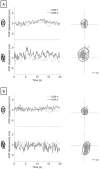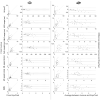Standard versus innovative robotic balance assessment for people with multiple sclerosis: a correlational study
- PMID: 37491303
- PMCID: PMC10369743
- DOI: 10.1186/s40001-023-01223-2
Standard versus innovative robotic balance assessment for people with multiple sclerosis: a correlational study
Abstract
Introduction: Balance disorders are common in people with Multiple Sclerosis (PwMS) and, together with other impairments and disabilities, often prevent PwMS from performing their daily living activities. Besides clinical scales and performance tests, robotic platforms can provide more sensitive, specific, and objective monitoring. Validated technologies have been adopted as gold standard, but innovative robotic solutions would represent an opportunity to detect balance impairment in PwMS.
Aim: Study's aim was to compare postural assessment of 46 PwMS with a relapsing-remitting form during static tasks performed with the novel robotic platform hunova® and the gold standard EquiTest®, METHODS: Pearson's r was run on Center of Pressure (COP)-related parameters and global static balance measures computed from hunova® and EquiTest® in eyes-open (EO) and eyes-closed (EC) conditions. In addition, agreeableness level toward the use of both devices was tested through numeric rating scale.
Results: Considering COP-related parameters, correlations were significant for all measures (p < .001). Interestingly, in EO, a strong correlation was shown for sway area (r = .770), while Medio-Lateral (ML) and Anterior-Posterior (AP) oscillation range, path length, ML and AP speed, ML and AP root mean square distance had a relatively strong association (.454 ≤ r ≤ .576). In EC, except for ML oscillation range showing a relatively strong correlation (r = .532), other parameters were strongly associated (.603 ≤ r ≤ .782). Correlations between global balance indexes of hunova® and EquiTest® revealed a relatively strong association between the Somatosensory Score in EquiTest® and the Somatosensory Index in hunova® (r = - .488). While in EO Static Balance Index from hunova® was highly correlated with Equilibrium score of EquiTest® (r = .416), Static Balance Index had a relatively strong association with both the Equilibrium (r = .482) and Strategy Score (r = .583) of EquiTest® in EC. Results from agreeableness rating scale revealed that hunova® was highly appreciated compared to EquiTest® (p = .044).
Conclusions: hunova® represents an innovative adjunct to standard robotic balance evaluation for PwMS. This confirms that combining traditional and robotic assessments can more accurately detect balance impairments in MS.
Keywords: Balance; EquiTest®; Hunova®; Multiple sclerosis; Posturography.
© 2023. The Author(s).
Conflict of interest statement
GM, VS and ADL are actually working at Movendo Technology that developed hunova®. Other authors declare that they have no competing interests.
Figures



Similar articles
-
Testing Dynamic Balance in People with Multiple Sclerosis: A Correlational Study between Standard Posturography and Robotic-Assistive Device.Sensors (Basel). 2024 May 23;24(11):3325. doi: 10.3390/s24113325. Sensors (Basel). 2024. PMID: 38894116 Free PMC article.
-
Static posturography across the EDSS scale in people with multiple sclerosis: a cross sectional study.BMC Neurol. 2016 May 20;16:70. doi: 10.1186/s12883-016-0603-6. BMC Neurol. 2016. PMID: 27206921 Free PMC article.
-
Postural stability is a valid and meaningful disability metric in progressive MS with potential for use in neuroprotective therapy trials.Mult Scler Relat Disord. 2021 Jul;52:102946. doi: 10.1016/j.msard.2021.102946. Epub 2021 Apr 11. Mult Scler Relat Disord. 2021. PMID: 33901968
-
Measurement of balance in computer posturography: Comparison of methods--A brief review.J Bodyw Mov Ther. 2011 Jan;15(1):82-91. doi: 10.1016/j.jbmt.2008.03.003. Epub 2008 May 8. J Bodyw Mov Ther. 2011. PMID: 21147423 Review.
-
Influence of footwear on postural sway: A systematic review and meta-analysis on barefoot and shod bipedal static posturography in patients and healthy subjects.Gait Posture. 2022 Feb;92:302-314. doi: 10.1016/j.gaitpost.2021.11.022. Epub 2021 Nov 26. Gait Posture. 2022. PMID: 34902659
Cited by
-
Robotic systems for upper-limb rehabilitation in multiple sclerosis: a SWOT analysis and the synergies with virtual and augmented environments.Front Robot AI. 2024 Feb 27;11:1335147. doi: 10.3389/frobt.2024.1335147. eCollection 2024. Front Robot AI. 2024. PMID: 38638271 Free PMC article. Review.
-
Testing Dynamic Balance in People with Multiple Sclerosis: A Correlational Study between Standard Posturography and Robotic-Assistive Device.Sensors (Basel). 2024 May 23;24(11):3325. doi: 10.3390/s24113325. Sensors (Basel). 2024. PMID: 38894116 Free PMC article.
References
-
- Cella A, De LA, Squeri V, Parodi S, Puntoni M, Vallone F, et al. Robotic balance assessment in community - dwelling older people with different grades of impairment of physical performance. Aging Clin Exp Res. 2019 - PubMed
-
- Sebastião E, Sandroff BM, Learmonth YC, Motl RW. Validity of the timed up and go test as a measure of functional mobility in persons with multiple sclerosis. Arch Phys Med Rehabil. 2016;97(7):1072–1077. - PubMed
-
- Cattaneo D, Don F, Gnocchi C, Jonsdottir J, Don F, Gnocchi C. Reliability of four scales on balance disorders in persons with multiple sclerosis. Arch Phys Med Rehabil. 2008 - PubMed
MeSH terms
LinkOut - more resources
Full Text Sources
Medical

